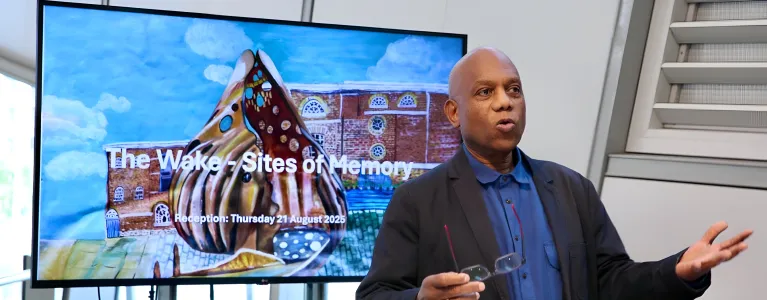
Four years ago, when the GLA relocated City Hall to its new Royal Docks home, it added to the three other historical powerbroking symbols already established in East London.
It stands in the postcode E16. Virtually next door, in postcode E14, is, unmistakably, Canary Wharf, the shiny glass-and-marble overspill of London’s financial behemoth, The City of London, still in its original postcode EC2.
Also extant in E14 is East India Quay. Mooring at its dock, all the tea from China via India would arrive to radically alter English tastebuds amongst the other luxury imports from the subcontinent, courtesy of the East India Company.
And a stone’s throw away from that harbour, of slightly older vintage, is West India Quay. It was dredged from the River Thames at the beginning of the nineteenth century to handle the even more valuable and lucrative trade and goods from Britain’s so-called ‘West India’ slave plantations. The most profitable and wealth-generating product of those fields of brutal terror and abject misery was ‘king sugar’. It was reaped, under conditions of tyranny, by the world’s first ever population of chattel slaves.
If you follow the adjacent thoroughfares from these two Thames-side ports, East India Dock Road and West India Dock Road, they converge eventually at Limehouse to become the aptly named Commercial Road. This highway took the imported imperial merchandise on to the retail and financial markets of postcode EC2 and beyond.
Along the full stretch of the cobbled dockside of West India Quay is a terraced Georgian brick building. Its numerous snug windows are typical of the period, elegant arches with the glass protected by ornate filigree ironwork.
Nowadays, there’s a spread of fancy dining units lining the front of the building and overlooking the dock. Their tabled al fresco spaces spill out to borders of flamboyant flower arrangements: there’s a Biergarten, a pizza palace, even a vendor offering a burger-with-lobster special.
If you tilt your gaze above the ground floor to the upper storeys you’ll notice there are no exterior doorways, only more windows, some larger than others. And, curiously, dotted between these windows are the chain remnants of several pulleys and winches which reach to the very roof.
The only anomaly amongst this foodie excess is the narrow entrance of the 22-year old London Museum Docklands. Located on its topmost floor, in a modest dedicated space, is the permanent gallery London Sugar & Slavery, which opened in November 2007. I served as one of seven external advisors who helped establish it. For us, however, the Grade 1 listed building itself is Exhibit A in the gallery’s meaning.
This was the first acknowledgement by the city’s museum sector of London’s pivotal position in the Transatlantic Trafficking of Enslaved Africans (the TTEA). For close on 250 years, this stretch of the River Thames was the crucial point of departure for slaving vessels on the First Passage (or The Outward Voyage) of the trade, to the Atlantic coast of Africa. Later, the destination of the equally crucial Final Passage (or The Home Voyage) with the sweat-and-blood soaked produce from the ‘West India’ slave plantations: hogsheads of sugar, puncheons of rum, casks of molasses and bales of tobacco. The only possible presence of an enslaved African on the quay would have been as a pressganged sailor in a ship’s crew.
The London Sugar & Slavery gallery is therefore housed in an old sugar warehouse, completed in 1802. It was a cog in the industrial machine of the TTEA. The built environment of West India Quay is at the apex of what was a wretched and accursed triangular trade with human cargo at its core. As the carved plaque on the end wall of the building declares ‘[it is part of] an undertaking, under the favour of God, for the Stability, Increase and Ornament of British Commerce.’ Stability and Increase may have gone away with the decline of cane sugar production in the British West Indies. In its contemporary appearance the structure has become merely ornamental, like much of the legacy of the TTEA which is all round us in London.
But it was the Middle Passage, the six to eight weeks of shackled transport across the Atlantic Ocean (‘From Senegal to San Salvador’, as mapped in the words of St Lucian poet and Nobel laureate, Derek Walcott), which became the baptism in dehumanisation, marking the onset of the defining horror and violence of the decades-into-centuries long TTEA.
In the witness of Olaudah Equiano from the first autobiography by a formerly enslaved African, published here in London in 1789, the cramped and fetid conditions of a slave ship ‘produced copious perspirations, so that the air soon became unfit for respiration…and brought on a sickness among the slaves, of which many died, thus falling victims to the improvident avarice…of their purchasers.’
The hope must be that with the placement of Khaleb Brooks’ bronze installation, The Wake, in plain sight of the fancy diners and of pedestrian traffic, between the dock and the museum’s entrance, the necessary redefinition of West India Quay, from an ornament to a memorial, can begin to take hold.
About Burt Caesar
Burt Caesar was born in St Kitts and schooled there and in Leeds. He is an actor and director who has worked extensively across British theatre, television and film. He was a founder member of the pioneering company Black Theatre Cooperative. He is a former Associate Director at the Royal Court Theatre and an Artistic Advisor at RADA. He is a broadcaster, as a reviewer and as a documentary maker, across BBC Radio platforms. He was also an adviser in establishing the permanent gallery London Sugar & Slavery at London Museum Docklands in 2007.